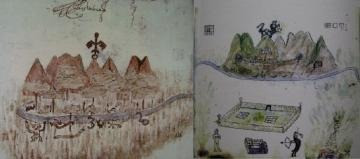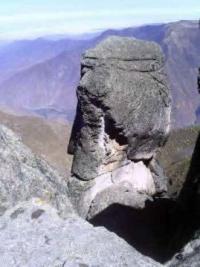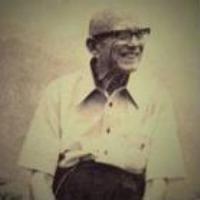Copy Link
Add to Bookmark
Report
SURFPUNK Technical Journal 078

Date: Mon, 12 Apr 93 13:48:49 PDT
Reply-To: <surfpunk@osc.versant.com>
Return-Path: <cocot@osc.versant.com>
Message-ID: <surfpunk-0078@SURFPUNK.Technical.Journal>
Mime-Version: 1.0
Content-Type: text/plain
From: surfpunk@osc.versant.com (orvat qvfpbeqvnaf jr qbag zvaq)
To: surfpunk@osc.versant.com (SURFPUNK Technical Journal)
Subject: [surfpunk-0078] DIGEST: cyberpunk, ZUMABOT, NREN, FBI, zero-knowledge
# While I got a chuckle out of seeing my subscription
# request quoted in the SURFPUNK "FAQ", I still have no
# clear notion of what SURFUNK is. After a couple
# months being on the list, while I like it, I don't
# know what to make of it.
#
# But, being a discordian, I don't entirely mind. (-:
#
# -- Nowhere Man <rpowers@Panix.Com>
# However, if you want to be relatively more realistic,
# try Arachnet, and some of the more innovative places
# like Leri, Fnord, Surfpunk, Future-technologies,
# Info-futures, Extropians, etc....
#
# -- Andy Hawks <ahawks@nyx.cs.du.edu>
The above are greps from futureCulture.
Here's a grep from this surfpunk. --strick
:g/Subject:/#
36 Subject: Re: [surfpunk-0076] TALLY: who are surfpunk?
59 Subject: ZUMABOT strikes back
110 Subject: Plan for 'info-highway' runs into FBI road block
185 Subject: MATH: Zero Knowledge Proofs
373 Subject: Telecomm statement on NREN, etc.
382 Subject: Telecomm statement on NREN, etc.
[Hit return to continue]
________________________________________________________________________
________________________________________________________________________
From: Mike Mitten <gnome@noel.pd.org>
Subject: Re: [surfpunk-0076] TALLY: who are surfpunk?
To: surfpunk@osc.versant.com
Date: Thu, 8 Apr 1993 09:41:50 -0400 (EDT)
dionf@ERE.UMontreal.CA (Francois Dion) writes:
>Which brings to mind an interview with a guy involved in the Black Label
>publicity here (from the firm Cossette i think) and the guy said they wanted
>to give the tv adds a "cyberpunk look". We better get used to bad uses of
>the term by technologically challenged people...
This implies that there is a *good* use of the term cyberpunk. Which
there is not, as it describes nothing, and serves only to let people
know the extent of the coolness of the person using the word.
-Mike
Mike Mitten - gnome@pd.org - ...!emory!pd.org!gnome - AMA#675197 - DoD#522
Irony is the spice of life. '90 Bianchi Backstreet '82 Suzuki GS850GL
"The revolution will not be televised."
________________________________________________________________________
To: surfpunk@osc.versant.com
Subject: ZUMABOT strikes back
Date: Mon, 12 Apr 93 0:31:50 BST
From: jm@maths.tcd.ie
More news on the zuma.uucp flamebots/NLP-frankensteins...
--
-><- "I find the law of fives to be more evident every time I look" -><-
Justin Mason (Iona Technologies' techie-in-residence and unix caretaker)
<jm@maths.tcd.ie> -- generic <jmason@iona.ie> -- MIME-extended
phone: +353-1-6790677 fax: +353-1-6798039
In article <1993Apr10.190716.3431@mnemosyne.cs.du.edu> jfurr@nyx.cs.du.edu (Joel Furr) writes:
>It's like this. Warren Burstein and I newgrouped alt.fan.serdar-argic to
>celebrate the follies of the infamous ZUMABOT. Then the 'bot got all
>snotty and:
>
>1) forwarded all mail from sera@zuma.anatolia.org to warren@nysernet.org
>2) newgrouped alt.fan.joel-furr (which doesn't look to have gone very far)
>3) tried to rmgroup alt.fan.serdar-argic
>4) signed Warren up for about sixty mailing lists
>5) sent email to our news admins asking to have our accounts yanked
>6) threatened legal action against us
>7) went berserk and cancelled every current post it could find authored by
> sera@zuma.uucp (our guess is so as to be able to claim that it really
> hasn't posted all that many articles)
>
>But at no point did it newgroup alt.fan.warren.burstein, and Warren's
>upset because he got left out. Doesn't that damn 'bot have any sensitivity?
I *love* it! Warren and I got into it (actually, *I* did) last Pesach, and
I have felt bad about it ever since. So seeing alt.fan.warren.burstein
gave me such nachus, that I *had* to add it to my .newsrc!
Ya gotta love that zumabot -- hell, zumabot posting to s.c.j. and t.p.m.
account for some 50% of what my KILL files junk!
But tell me, is warren.burstein anything like howard-stern? Does warren
have a "robin"?
--
Yonatan B. Horen | Jews who do not base their advocacy of Jewish positions and
(408) 736-3923 | interests on Judaism are essentially racists... the only
horen@netcom.com | morally defensible grounds for the preservation of Jews as a
| separate people rest on their religious identity as Jews.
_______________________________________________________________________
Source: Atlanta Journal / Atlanta Constitution, 12apr93, p A11
Subject: Plan for 'info-highway' runs into FBI road block
Author: Andrew Glass
About-The-Author: Andrew J. Glass is chief of the
Cox Newspapers Washington bureau.
Washington -- It was the kind of story sure to make big news: Hired
Killers with links to Libya down a domestic jet over Chicago with a
hand-held rocket launcher. But it didn't happen. The FBI got a timely
tip, tapped a phone line and foiled the plot.
An FBI memo that now sits on the desk of Attorney General Janet Reno
suggests that kind of police work may not be so easy in the new age of
all-digital phone networks. All the court orders under the sun won't
get you in if the data is encoded and if the FBI lacks the key.
The FBI is pushing hard for a new law to alter the design of the next
wave of voice and data lines in ways that would make it easier to tap
them. Otherwise, the bureau fears, its future wiretaps will yield only
the stillness of glass fibers, pulsating at the speed of light.
Basically, all we're trying to do is just keep the status quo, says an
FBI agent. His agency, he points out, isn't asking for anything more
intrusive than it already has. If society wants us to hit organize
[sic] crime, thwart terrorists and catch spies, then Congress must act,
he argues.
But it won't happen soon. And it may never happen. For, on this
issue, the G-men face a long list of foes.
The list begins with the civil liberties folks. Already, they see, not
without some cause, Big Brother keeping score. In such circles, they
say, the FBI might just as well call for a ban on gloves. Since gloves
don't leave any fingerprints, they make life harder for cops.
Nor are the mega-owners of what Time magazine dubs "The Info Highway"
all that happy about what the FBI now wants from them. While phone
people have long been known for playing ball with the police, in these
tough times they think the customer must come first.
Money, to be sure, is an issue. But that isn't their main fret with
being bound to build hidden "back doors" into their networks. While
designed to be opened only by the FBI, one can see how others may also
learn to tap dance [truly sic].
People have been making up codes for a very long time. Even now that
we are buddy-buddy with the Russians, the secret National Security
Agency employs upward of 35,000 code breakers. In the digital world,
however, there are only two states of being -- on or off. On paper,
they look like an endless chain of near-meaningless strings of zeros
and ones. They also hold out the hope (and, for the FBI, the fear) of
true privacy.
Despite the huge stakes for both sides in this fight, the public debate
has been muted. Here and there, a few trade journals review the
arguments. Secret (and coded) memos cut an electronic path through the
federal maze as sets of officials seek the comments of their peers and
of higher-ups.
Last year, President Bush backed the FBI view. The agency wrote new
entry standards that would let it break into fax machines, cellular
phones and private data networks. But Congress balked.
The new attorney general has yet to tip her hand. In time, this issue
will reach the White House. The current occupant has never seen a
technology he didn't like. And President Clinton also has a thing
about wanting to please people. However he comes down on this one,
he's likely to leave some people mad.
________________________________________________________________________
Date: Wed, 7 Apr 93 21:31:39 -0700
To: Extropians@gnu.ai.mit.edu
From: tcmay@netcom.com (Timothy C. May)
Subject: MATH: Zero Knowledge Proofs
Cc: cypherpunks@toad.com
[Since this should also be of interest to the Cypherpunks list, which Ray
is/was subscribed to, I am posting this essay to that list.]
Ray Cromwell writes:
> Could someone explain zero knowledge proofs and give me an example. I
>have taken number theory and abstract algebra so feel free to use equations.
>
>(I know that zero knowledge proofs are a way of certifying something without
>revealing the information you are certifying, but I want to know how they
>work mathematically)
Zero knowledge interactive proof systems ("ZKIPS") are sometimes called
"minimum disclosure proofs" (with some subtle differences) and are exciting
and mysterious (at first) methods that lie at the heart of modern
cryptology. Here's a simple explanation. Too bad we don't have a
blackboard!
ALICE AND BOB (some people call them Peggy the Prover and Vic the Verifier)
Alice wishes to prove to Bob that she knows some item of knowledge without
actually giving Bob any of that knowledge.
Let us first imagine that Alice claims she knows a "Hamiltonian cycle" on a
particular graph. (For a given set of nodes and arcs linking some of those
nodes, a Hamiltonian cycle is one which passes through each node once and
only once. You might want to draw some graphs on a sheet of paper and try
to find a Hamiltonian cycle for the graphs, to get a feel for the problem.)
The particular graph may be "registered" somewhere with Alice's claim that
she--and only she, for reasons I'll discuss at the end--knows a Hamiltonian
cycle for the graph. In a sense, this is her "proof of identity."
To make this example concrete, Alice is using this piece of knowledge as
her *password* to get into some system. She presents a map of 50 cities
and some set of highways interconnecting them and says "I am who I say I am
if and only if I know a Hamiltonian cycle for this graph."
The conventional (non zero knowledge) way to convey this knowledge is for
Alice to simply *show* the Hamiltonian cycle to Bob. This is how passwords
are currently handled. Bob, and anybody else who is spying on the exchange,
then knows the "secret," which isn't a secret anymore. (Anybody who saw the
exchange, including Sysadmin Bob, could then impersonate her.)
ENTER ZERO KNOWLEDGE
Alice, instead of showing Bob the Hamiltonian cycle, takes the cities and
covers them with something, say, coins. (On a computer, this is all done in
software, using the cryptographic protocol called "bit commitment.")
Alice scrambles the position of the cities (covered by coins) so as not to
allow positional cues. (Most of the 50 cities should have about the same
number, ideally exactly the same number, of links to other cities, to
ensure that some cities are not "marked" by having some unique number of
links. A detail.) Needless to say, she scrambles the cities out of sight of
Bob, so he can't figure out which cities are which. However, once she's
done with the scrambling, she displays the cities in such a way that she
can't *later change*..i.e., she "commits" to the values, using well-known
cryptographic methods for this. (If this sounds mysterious, read up on it.
It's how "mental poker" and other crypto protocols are handled.)
Bob sees 50 cities with links to other cities, but he doesn't have any way
of knowing which of the covered cities are which. Nor, I should add, are
the links labelled in any way--it wouldn't do to have some links
permanently labelled "Route 66" or "Highway 101"!
She says to Bob: "Pick one choice. Either you can see a Hamiltonian cycle
for this set of covered cities and links, or you can see the cities
uncovered." In other words, "Alice cuts, Bob chooses."
Bob tosses a coin or chooses randomly somehow and says: "Show me the cities."
Alice uncovers all the cities and Bob examines the graph. He sees that
Akron is indeed connected to Boise, to Chicago, to Denver, not to Erie, and
so on. In short, he confirms that Alice has shown him the original graph.
No substitution of another graph was made.
Bob, who is suspicious that this person is really who she claims to be,
says to Alice: "Ok, big deal! So you anticipated I was going to ask you to
show me the cities. Anybody could have gotten Alice's publicly registered
graph and just shown it to me. You had a 50-50 chance of guessing which
choice I'd make."
Alice smugly says to him: "Fine, let's do it again." She scrambles the
cities (which are covered) and displays the graph to Bob...50 covered
cities and various links between them. She tells Bob to choose again.
This time Bob says: "Show me the Hamiltonian cycle."
Without uncovering the cities (which would give the secret away, of
course), Alice connects the cities together in a legal Hamiltonian cycle.
Bob says, "OK, so this time you figured I was going to ask you the opposite
of what I did last time and you just substituted some other graph that you
happened to know the Hamiltonian cycle of. I have no guarantee the graphs
are really the same."
Alice, who knows this is just the beginning, says: "Let's do the next round."
...and so it goes....
After 30 rounds, Alice has either produced a legal Hamiltonian cycle or a
graph that is the same as (isomorphic to...same cities linked to same other
cities) the registered graph in each and every one of the rounds.
There are two possibilities:
1. She's an imposter and has guessed correctly *each time* which choice Bob
will make, thus allowing her to substitute either another graph altogether
(for when Bob wants to see the Hamiltonian cycle) or just the original
graph (for when Bob asks to see the cities uncovered to confirm it's the
real graph). Remember, if Alice guesses wrong even once, she's caught
red-handed.
2. She really is who she claims to be and she really does know a
Hamiltonian cycle of the specified graph.
The odds of #1 being true drop rapidly as the number of rounds are
increased, and after 30 rounds, are only 1 in 2^30, or 1 in a billion. Bob
choose to believe that Alice knows the solution.
Alice has conveyed to Bob proof that she is in possession of some knowledge
without actually revealing any knowledge at all! The proof is
"probabilistic."
This is the essence of a zero knowledge proof. There's more to it than just
this example, of course, but this is the basic idea.
SOME DETAILS
1. Could someone else discover the Hamiltonian cycle of Alice's graph?
Exhaustive search is the only way to guarantee a solution will be
found--the Hamiltonian cycle problem is a famous "NP-complete"
combinatorial problem. This is intractable for reasonable numbers of nodes.
50 nodes is intractable.
2. If finding a Hamiltonian cycle is intractable, how the hell did Alice
ever find one?
She didn't *have* to find one! She started with 50 cities, quickly
connected them so that the path went through each city only once and then
wrote this path down as her "secret" solution. Then she went back and added
the other randomly chosen interconnects to make the complete graph. For
this graph, she obviously knows a Hamiltonian cycle, *by construction*.
3. Can Bob reconstruct what the Hamilonian cycle must be by asking for
enough rounds to be done?
Not generally. Read the papers for details on this, which gets deeply into
under what circumstance partial knowledge of the solution gives away the
complete solution.
4. Are there other problems that can be used in this same way?
Yes, there are many forms. I find the Hamiltonian cycle explanation quite
easy to explain to people. (Though usually I can draw pictures, which helps
a lot.)
5. How general is the "zero knowledge interactive proof" approach?
Anything provable in formal logic is provable in zero knowledge, saith the
mathematicians and crypto gurus. Check out the various "Crypto Conference"
Proceedings.
Hope this helps.
-Tim May
--
Timothy C. May | Crypto Anarchy: encryption, digital money,
tcmay@netcom.com | anonymous networks, digital pseudonyms, zero
408-688-5409 | knowledge, reputations, information markets,
W.A.S.T.E.: Aptos, CA | black markets, collapse of governments.
Higher Power: 2^756839 | Public Key: MailSafe and PGP available.
_______________________________________________________________________
To: surfpunk@osc.versant.com
From: "Gregory L. Searle" <GSEARLE@ccs.uoguelph.ca>
Date: 9 Apr 93 01:28:13 EDT
Subject: Telecomm statement on NREN, etc.
Reply-To: GSEARLE@ccs.uoguelph.ca
Here it comes, Third-Hand. More info on NSFNET and NREN.
------- Forwarded Message Follows -------
Date: Fri, 26 Mar 1993 18:01:20 EST
From: Jim Conklin <CONKLIN@BITNIC.BITNET>
Subject: Telecomm statement on NREN, etc.
To: Multiple recipients of list BITNEWS <BITNEWS@UGA.BITNET>
This may be of general interest to those of you wondering what's coming (and
why) with the NSFNET and NREN. / Jim
----------------------------Original message----------------------------
Finally a clear statement of what they want and why the NSF is planning
changes to the backbone funding and usage.
For Release: March 23, 1993
LEADING TELCO CEOs JOINTLY SUPPORT
CLINTON-GORE TECHNOLOGY INITIATIVE
The Chief Executive Officers of the nation's leading local and
long-distance telecommunications companies today announced that
they have signed a landmark public policy position statement
(attached) -- signaling strong industry-wide support for the
communications technology initiatives envisioned by the Clinton-
Gore Administration.
The statement was signed by the CEOs of Ameritech, AT&T, Bell
Atlantic, Bellcore, BellSouth, Cincinnati Bell, Inc., GTE, MCI,
NYNEX, Pacific Telesis, Southern New England Telephone Company,
Southwestern Bell Corp., Sprint,
U S WEST.
The policy statement provides a set of principles consistent with
the Administration's initiative, "Technology for America's Economic
Growth, A New Direction to Build Economic Strength," and
articulates the roles government and industry should play.
The CEOs suggest the Administration and Congress adopt these
principles as a framework for cooperation among federal, state and
local governments, key users communities -- such as schools,
libraries and health care providers -- and the private sector
(including telecommunications, computer, information, and related
industries.)
In addition, the set of principles recommends that government
support research on applications and services that benefit schools,
health care, and industries crucial for U.S. competitiveness, as
well as research that will make it easier for people to connect to,
and use, information networks.
Benefits to come from following these principles would include:
* Increased private sector investment in, and continued development
of, a national information infrastructure as a result of
government serving as a catalyst.
Partnerships among government, academia, industry and key user
communities will focus on development of experimental technologies
that leverage limited government funds.
Transferring experimental technologies to commercial (production)
networks will provide new capabilities to users, meet their
expanding needs, and increase industry's investment in the
infrastructure.
* Alternative visions of the national information infrastructure
can be integrated into a common vision which provides interactive
multi-media and other advanced networking capabilities to all
Americans.
* Industry's incentive to invest in the infrastructure will remain
strong because the government will not subsidize commercial networks
and because commercial services will not be provided on government-
supported experimental networks.
* Selected user communities will be provided support for access to,
and use of, networks and information through government funding.
Supporting these communities represents a shift of emphasis from
government's direct support of networks. These funds,
predominantly grants, would be carefully targeted by the government
to meet urgent societal needs by communities which otherwise could
not afford to take advantage of the benefits that the
infrastructure can provide -- for example, innovative math and
science programs for children in public schools with limited
budgets and resources.
* Alternative network suppliers will be able to interconnect
seamlessly with each other, resulting in a wide array of
competitive choices that will spur innovation and result in
competitive prices to users.
According to George Heilmeier, President and CEO of Bellcore, "The
telecommunications industry looks forward to the challenge of
evolving information networks to meet urgent societal needs, spur
economic growth, and strengthen America's competitive position in
the global economy."
.
Policy Statement
1. The High Performance Computing and Communications (HPCC)
vision should be expanded to foster the emergence of services and
applications that will serve the urgent societal needs of a broad
range of users and industries, such as K-16 education, health
care delivery and cost containment, manufacturing productivity
and job creation, and the general public through telecommuting
and access to libraries and other databases. This imperative is
shared with the recommendations of the Computer Systems Policy
Project (CSPP).
2. This expanded vision can be most effectively served by a
target structure comprised of separate Experimental and
Production Networks. Experimental Networks should consist of
government supported testbeds (for example, the Gigabit testbeds)
and high performance national testbeds (for example,
interconnecting major supercomputer research sites) for leading
edge networking technology and applications requiring such
technology. Experimental Networks supported by the government
should be used only:
a) To carry traffic directly related to the experimental goals
of these networks, and
b) By those researchers who need to perform applications that
require the advanced technological capabilities of these
networks, and which cannot be performed on Production Networks.
These Experimental Networks will be developed by partnerships
among government, academia, private industry and target user
communities. These partnerships, which can build upon the long
and successful collaboration between industry, academia and
government, can leverage the government's limited resources to
maximize social return.
Production Networks should consist of present and future
commercially available communications networks. Production
Networks would:
a) Be built, managed and operated by multiple providers from the
private sector;
b) Provide a vehicle for technology transfer from their
experimental counterparts;
c) Offer commercial networking capabilities to the business and
residential population; and
d) Serve all users, including the Research and Education
Community, for those applications that can be supported by
commercially available network services.
The government, private sector and key user communities should
jointly implement transition steps to achieve this target
structure.
3. The government should encourage maximum interconnectivity and
interoperability among Production Networks as an important goal
of public policy.
4. The following four activities should be supported by the
government and given the highest priority for achieving broad
societal benefits:
a) Research into applications and services that will provide for
the urgent needs of the broad range of users in K-16 education,
health care and industries critical for U.S. competitiveness.
b) Research into user-friendly access and use of the networks to
promote broad utilization by all members of society.
c) Direct subsidies to the Research and Education communities to
support their access to and use of Production Networks.
d) Technical development of the Experimental Networks, including
continued support of the Research and Education community's
contributions in developing these networks.
5. Full consideration should be given to the present and future
developments of the computer, telecommunications, information and
related industries when planning, designing, and implementing the
technology and standards for the Experimental Networks. Giving
full consideration to the developments in all these industries
will help ensure the maximum transfer of the best and most
effective technology from the Experimental to the Production
Networks.
6. Decision making processes-relative to government programs
associated funding should be open to the target user community,
including K-16 educational institutions, libraries, the health
care industry, and industries critical to U.S. competitiveness.
G.L. Searle
+-------------------------------------+
|Gregory L. Searle Political Studies|
|Computing and Communications Services|
|University of Guelph, Ontario, CANADA|
|(Home): 519-767-2500 N1G 3E1|
| <gsearle@ccs.uoguelph.ca> |
| <ccssearl@vm.uoguelph.ca> |
+-------------------------------------+
________________________________________________________________________
________________________________________________________________________
The SURFPUNK Technical Journal is a dangerous multinational hacker zine
originating near BARRNET in the fashionable western arm of the northern
California matrix. Quantum Californians appear in one of two states,
spin surf or spin punk. Undetected, we are both, or might be neither.
________________________________________________________________________
Send postings to <surfpunk@osc.versant.com>, subscription requests
to <surfpunk-request@osc.versant.com>. MIME encouraged.
Xanalogical archive access soon. All trains should be free.
________________________________________________________________________
________________________________________________________________________




















